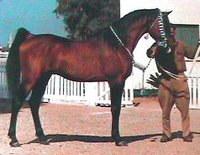 |
| Haddiyah (Amaal x *Nihal) |
Haddiyah, a 1975 grey mare, was bred by Gleannloch Farms. Sired by Amaal (*Morafic x *Bint Maisa el Saghira) and out of *Nihal++(Anter x Neamat), one of ten Anter daughters that Gleannloch imported from Egypt. *Nihal was imported in 1968 and in 1971, she was named a US National Western Pleasure Champion, as well as a Top Ten English Pleasure Champion. The ++ after her name indicates that she was honored with a Legion of Merit.
One of the things that I love most about the Arabic language is how one word can elicit so many beautiful thoughts, all at one time. And so it is with Haddiyah, an integrous name which inspires fresh idealism, born of a decisive spirit, laser-focused on fulfilling her destiny. Can you think of a more perfect name for a promising broodmare like Haddiyah? In his extraordinary book, The Egyptian Alternative, Volume II, noted author and breeder, Philippe Paraskevas wrote,
"Nobility, timber and character defined Anter in his day as the Waley El Abd [the crown prince] of Inshass, the heir-apparent to Hamdan as sire of the King's khassa."
As a maternal granddaughter of Anter, one is not surprised by the noble character that Haddiyah possesses and this very special mare, I feel, was appropriately named by her breeders, the late Douglas & Margaret Marshall of Gleannloch Farms.
Hadban Enzahi by strain, Haddiyah, in her maternal line traces to Venus, an 1890 chestnut mare who was imported to Egypt and was later incorporated into the stud of Khedive Abbas II. However, if you study the 4th and 5th generations of her pedigree, you will learn that Haddiyah is one of those horses who is a little bit of everything and therefore, despite our breed tradition, it is challenging to box her within a strain, only because of her tail female line. In studying her eight grandparents, she is as much Saqlawiyah, as she is Hadbah (31.25%), plus a slightly smaller percentage of the Dahman strain, approximately 25%. If you go out one more generation, to the great grandparents, the Saqlawi and Dahman strains reverse percentages of influence and we pick up the additional strain of Kuhaylan Mimriah, through the double dose of Mansour.
Haddiyah was owned by William Hewitt and Patricia Wiman of Friendship Farm in East Moline, Illinois. Over the course of her breeding career, she produced 10 straight Egyptian foals, of which 8 were fillies. She was bred primarily to the stallion, Al Metrabbi (*Morafic x *Sammara), who sired 5 of her foals, including the only sons she produced. She was also bred multiple times to Rofann (*Soufian x Bint Romanaa), producing 3 daughters and interestingly, the only breedings that resulted in a color other than grey!
- 1984: Hayii, grey mare sired by El Naseet (Ibn Morafic x Sadeekah)
- 1985: Haadaya, grey mare sired by Al Metrabbi (*Morafic x *Sammara)
- 1986: Hajii, grey stallion, sired by Al Metrabbi (*Morafic x *Sammara)
- 1987: Hadibah, grey mare, sired by Al Metrabbi (*Morafic x *Sammara)
- 1988: Hakika, grey mare, sired by Al Metrabbi (*Morafic x *Sammara)
- 1989: Al Haram, grey stallion, sired by Al Metrabbi (*Morafic x *Sammara)
- 1990: Hadiyi, bay mare, sired by Rofann (*Soufian x Bint Romanaa)
- 1991: Habbi, chestnut mare, sired by Rofann (*Soufian x Bint Romanaa)
- 1992: Bint Haddiyah, grey mare, sired by Makhsous (*Sultann x *Nabda)
- 1994: Haynna, bay mare, sired by Rofann (*Soufian x Bint Romanaa)
Tragically, the beautiful Haddiyah died in 1994. She was 19 years old. Haddiyah represented the one and only cross of her dam, *Nihal, with *Bint Maisa el Saghira, an equally versatile mare. While one can argue that Haddiyah was not the sole representative of the Anter/*Bint Maisa el Saghira cross, as the 1967 chestnut mare, Dahma Il Ashekwar, sired by the Anter son, *Fahidd, was out of *Bint Maisa el Saghira. However, Haddiyah also has a double dose of *Morafic blood, so I feel, that the Haddiyah version, leaning more towards the Saqlawi strain, differed from the cross which resulted in Dahma Il Ashekwar. Regardless, Haddiyah's blood remains in the straight Egyptian gene pool, with 65 descendants through the present day. Her daughters were equally prolific as she herself was, in her 10-year career as a broodmare, producing foals for breeders like Ansata Arabian Stud, Silver Maple Farm, David & Martha Lucas of Whitehaven Farm, Julie Durral, Mary McGehee and Betty Skinner to name a few of the people connected to this wonderful mare and her unique cross of bloodlines. In closing, it is these breeders we need to thank, for preserving the unique combination of Anter and *Bint Maisa el Saghira, while insuring the perpetuation of these bloodlines for future straight Egyptian breeders.














